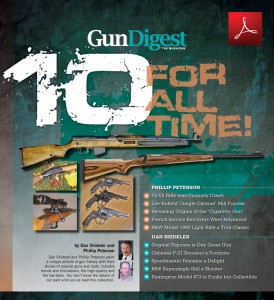You're one quick step away from your FREE DIGITAL PDF, Ten For All Time
Enter your e-mail in the box below and we'll give you IMMEDIATE ACCESS to this special digital compilation.
As an added bonus, we'll send you the industry's best e-mail newsletters from Gun Digest and Tactical Gear and the industry-leading companies' special offers, straight to your inbox. This FREE service is another benefit of being a fan and reader of Gun Digest.
[form id=”86681″]
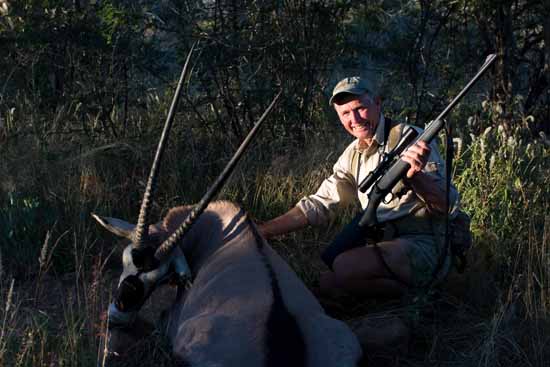
Big game that drops instantly to a shot is cause for concern.
Bullets don’t hurl animals to earth; an immediate collapse usually mean you’ve struck the spine. A severed spinal cord anchors the beast. If your bullet has also sent fragments through the chest or so shattered the forward spine as to deliver fatal shock, you won’t have to fire again.
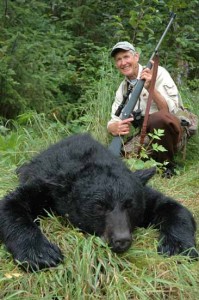
Without knowing that, you’d best cycle the bolt and ready yourself for another shot. Bullets that strike spinal processes – those short appendages on vertebrae – also deliver a hammer-like blow. But the animal can recover, sometimes within seconds. Once it regains its feet, you’ll likely not bag it unless another hit follows, pronto.
You can expect reaction to both bullet strikes and near misses. If the buck doesn’t react instantly, you probably missed. A bullet arrives faster than you can get your scope back on target, and the reaction is involuntary. If you see the deer duck, and it runs with tail up, it is likely unscathed. A deer that stands as if puzzled by the blast and sonic crack is almost surely untouched. Sudden noise can be hard to place; animals often pause, to determine a safe exit.
Up close you’ll seldom see the eruption of hair, dust or water, the flinch, the caving to the blow when your bullet lands. The violence of recoil will obscure all.
At distance, depending on light conditions, bullet velocity and your recovery time, you will. The sound of a strike follows reaction to the hit. A .270 bullet leaving at 3,000 fps averages about 2,700 fps over its first 300 yards. It reaches a deer 300 yards away in a third of a second. The thud of impact takes a second ambling back. You’ll hear the hit about 1 1/3 seconds after you fire.
The solid “thwuck” of a bullet through front ribs is welcome music. A sharp “whock” means you struck big bone; a sodden, splashy, hollow landing means a paunch hit.
Always assume a hit. Always reload quickly. Excepting offhand shots up close in timber, I stay in shooting position for at least 10 seconds after a shot. If game appears after the shot, I make sure it is the same animal before firing again.

Always check if you suspect a miss. First, flag your shooting spot and the place where the animal was when you fired (I carry ribbon for this purpose). Many deer are lost because hunters don’t follow up intelligently after the shot. Blood may not appear on the trail for many yards, even if the damage is lethal. I’ve found dead deer and elk many yards from where they were hit and had to back-trail to see any blood. A bullet that doesn’t pass through may cause lots of internal hemorrhage, only to have elastic hide slip over the entry hole during escape, impeding leaks.
Once, after calling a good shot at a deer in open woodland, I watched it gallop off at an even and deliberate pace. I followed the hoofprints but found no blood. Returning to the site of the hit, I got down on hands and knees, searching in circles. A tiny pink pellet with a single deer hair caught my eye. Lung.
Carefully, I worked my way along the trail again. This time I found a drop of blood. At a turn in the trail, I spied a track I’d missed before. The buck lay a few steps farther on.
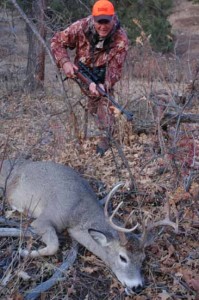
Game commonly makes an abrupt turn just before collapsing. A buck I hit too far back slipped into dense willows. I followed on hands and knees as the vegetation pressed in. There was no blood; it seemed as if the earth had swallowed this deer. Then I spotted a small gap to the side of what was now just a rabbit’s path. I crawled through it – and onto the carcass of the buck.
Perseverance is an asset. You might also call it a requisite. When you fire at big game, you have the responsibility to follow up. Some years ago, guiding a mule deer hunter, I spied a buck across a draw.
My client decided to shoot. The deer ran immediately. “Aw, I probably missed,” said the man, obviously not keen to cross the rugged draw and spend time on the deer’s trail. I insisted, though, and presently we stood where the animal had. “See, no blood.”
My companion wanted to start hunting again. I left him at the site and tracked the deer into timber, where I found it dead.
Lethal hits don’t always put game down immediately. In fact, most of the animals I’ve shot have moved before dropping. Regardless of the reaction, I always check and follow. As do all sportsmen.
Find Classic Sporting Rifles
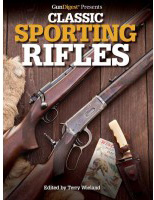 Retail: $24.99
Retail: $24.99
Your Price: $16.49
From Davy Crocket with “Old Betsy” to the mountain men and their Hawkens to the buffalo hunters and their Sharps and Winchester '73s – these are the rifles that fire the imagination. Gun Digest Presents Classic Sporting Rifles pays homage to these iconic guns with a wonderful compilation of articles written by a renowned panel of firearms writers of the 20th century.
Click here to order Gun Digest Presents Classic Sporting Rifles.

